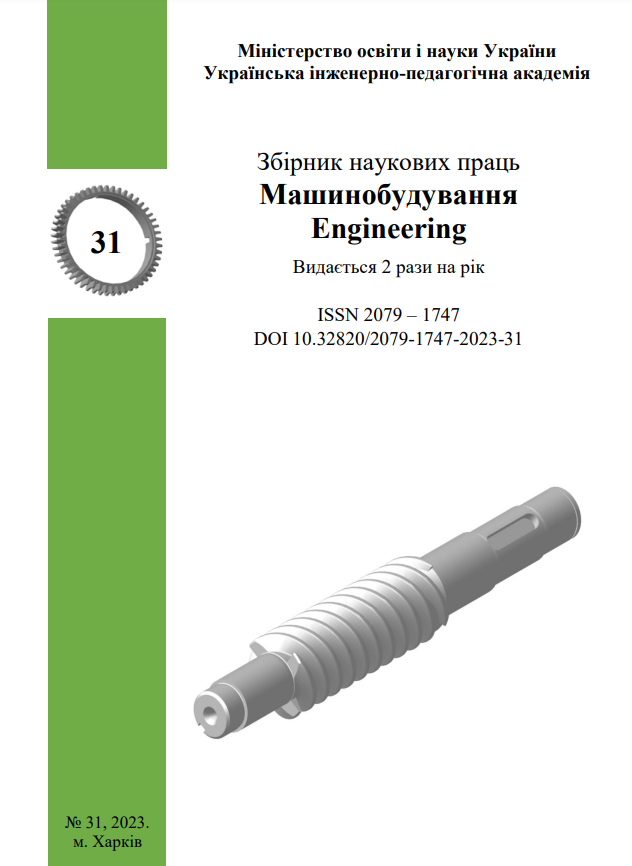Аnalysis of qualitative indicators of the use of different types of generators at mini HPP
Abstract
DOI: https://doi.org/10.32820/2079-1747-2023-31-61-70
The article presents the results of the analysis of qualitative indicators (analysis of technical
and economic indicators) of the use of various types of generators at low power hydroelectric power
plants (up to 800 kW). The energy potential of small and mini HPPs of Ukraine on small rivers and
the use of watercourses of technical water supply systems as well as the primary economically viable
and environmentally safe potential are shown. The analysis of the technical and economic characteristics of synchronous electric motors, asynchronous electric motors and DC electric motors used as
generators at low-power HPPs has been carried out. These indicators include the cost characteristics
of the relevant equipment in terms of installed capacity, weight and size indicators and the payback
period for the full operation of the HPP (the number of hours of use of the installed capacity is at least
4000). It has been established that the use of asynchronous electric motors with capacitive excitation
as a generator is the most promising solution, since the stability of the operation of electric drives of
mechanisms increases and the quality of energy increases, the asymmetry of linear and phase voltages
is leveled, and distortions are not introduced into the shape of the curve of linear and phase voltages,
there is no need to use complex automatic synchronization systems, protection against short circuits is
not required, and the reliability of HPP operation is increased. It has been established that the physical
processes of self-excitation of an asynchronous generator and the process of self-excitation can be attributed to an insufficiently studied issue in this direction. The disadvantages of using various types of
generators and methods for their elimination are determined. This study focuses on the cost analysis
of generators by examining the cost indicators of major manufacturers in Ukraine and several foreign
companies. The prices of generators were determined by calculating the average value across different
types and manufacturers. The research presents the results of an analysis of the technical and economic characteristics of various generator types based on their power ratings. Furthermore, the critical
power threshold is identified, which determines the optimal selection of generators from an economic
standpoint. The findings of this analysis provide valuable insights into the cost considerations and
technical performance of generators, aiding in informed decision-making for optimal generator selection in terms of economic efficiency.
Downloads
References
Krivcov, VS, Olejnikov, AM & Jakovlev AI 2003, Neischerpaemaja jenergija. Kn. 1: Vetrojelektrogeneratory, [Inexhaustible Energy. Volume 1: Wind Power Generators], Nac.ajerokosm. un-t «Har'k. aviac. in-t», Sevast. nac. tehn. un-t, Har'kov, Sevastopol'.
Derzhkomenerhrozberezhennia 1997, Prohrama rozvytku netradytsiinykh i vidnovliuvalnykh dzherel enerhii ta maloi hidro- i teploenerhetyky, skladova chastyna Natsionalnoi enerhetychnoi prohramy Ukrainy do 2010r., [The Program for the development of non-traditional and renewable energy sources and small hydro and thermal power, a component of the National Energy Program of Ukraine until 2010.], Kyiv.
Pojarkov, MF 1954, Sel'skie jelektricheskie stancii i podstancii, [Rural power plants and substations], Gos. izd-vo sel'hoz. lit., Moskva.
Mihajlov, LP, Fel'dman, BN & Markanova, TK 1989, Malaja gidrojenergetika, [Small hydropower], Jenergoizdat, Moskva.
Ang, KH & Chong, GLiY 2005, ‘PID control system analysis. design and technology’, IEEE Trans. on Control Syst. Tech., Vol.1, no. 4, Pp. 559-576.
Lurye, ZYa & Dmiterko, VN 2003, ‘Optimizatsiya parametrov PID-regulyatora sistemy upravleniya chastotoy vrashcheniya rotora gidroturbiny’, [Optimization of PID parameters of the hydraulic turbine rotor speed control system], Vestnik NTU «KhPI». Energeticheskiye i tekhnologicheskiye protsessy i oborudo-vaniye, no 9.
Astrorn, KJ & Hagglund, T 2006, ‘Advanced PID control’ ISA –The Instrumentation. Sysytem. and Automation Society, 460 p.
Li, Y., Ang, KH & Chong, GCY 2006, ‘Patents. Software. and Hardware for PID control. An overview and analysis of the current art’ IEEE Control Systems Magazine, Feb, Pp. 41-54.
Zhernyak, AP, Lurye, ZY & Dmiterko, VN 2001, ‘Kompyuternaya sistema regulirovaniya skorosti gidroturbiny’, [Computer-controlled hydraulic turbine speed control system], Vestnik NTU «KhPI». Tekhnologii v mashinostroyenii, no 7.
Zwart, PJ, Gerber, AG & Belamri, TA 2004, ‘Two-Phase Flow Model for Predicting Cavitation Dynamics’ ICMF 2004 In-ternational Conference on Multiphase Flow Yokohama. Japan. May 30 -June 3, Paper no. 152.
Kanyuk, GI, Mezerya, AYu, Irikov, DV & Melnikov, VE 2014, ‘Vliyaniye kolebaniy napora na tochnost regulirovaniya parametrov gidroturbin’, [Influence of head fluctuations on the regulation accuracy of hydraulic turbines], Skhіdno-Evropeyskiy zhurnal peredovikh tekhnologіy, no 3/2, Pp. 41-43.
Kanyuk, GI, Mezerya, AYu & Suk, IV 2016, Metody i modeli energosberegayushchego upravleniya energeticheskimi ustanovkami elektro-stantsiy, [Methods and models for energy-saving control of power plants], Tochka, Kharkov.
Kanyuk, GI, Bliznichenko, EN, Mezerya, AYu, Melnikov, VE & Babenko, IA 2015, Pretsizionnyye sistemy energosberegayushchego avtomaticheskogo regulirovaniya turbogene-ratornykh ustanovok elektricheskikh stantsiy, [Precision systems of energy-saving automatic control of turbine-generator units of power plants], Tochka, Kharkov.
Kanyuk, GI, Mezerya, AYu & Melnikov, VE 2015, ‘Pretsizionnyye sistemy avtomaticheskogo regulirovaniya gidroturbiny’, [Precision automatic control systems], Vіsnik Natsіonalnogo tekhnіchnogo unіversitetu “KhPІ”. Serіya “Energetichnі ta teplotekhnіchnі protsesi y ustatkuvannya”, no 17, Pp. 91-96.


